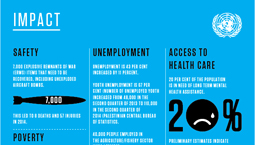We’ve just passed the first “anniversary” — if such a word can even be used with such a catastrophe — of Operation Protective Edge, Israel’s third invasion of the Gaza Strip in recent years. That small bit of land has now suffered more devastation than just about any place on the planet. In the wake of the third war since 2008, more than 100,000 displaced Gazans remain homeless or crowded in with relatives. Whole neighborhoods, destroyed in the conflict, have yet to be rebuilt. A year later, there is still next to no electricity, the area’s sole power plant having been taken out by Israeli air strikes, and the situation when it comes to sewage and potable water, is disastrous. Blockaded and devastated by repeated wars, Gaza’s manufacturing sector has almost disappeared, while its economy is “on the verge of collapse,” according to the World Bank. In short, by any standard, Gaza is not a livable place and yet 1.8 million people (more than half of them under 18 years old, 43% under 15) are crammed into it with nowhere to go and in most cases nothing to do. After all, Gaza now has what may be the highest unemployment rate on the planet at 44%, with youth unemployment reaching 60%.
The great Israeli reporter Amira Hass, author of the classic book Drinking the Sea at Gaza: Days and Nights in a Land Under Siege, recently put the matter this way: “In practice, Gaza has become a huge, let me be blunt, concentration camp… This is not a novelty… This did not start, unlike what many people think, with the rise of Hamas… This policy of sealing off Gaza, of making Gazans into… defacto prisoners, started [in 1991]… So if I want to sum up the reality of Gaza: it is a huge prison… It is an Israel-meditated, pre-meditated, pre-planned, and planned project to separate Gaza from the West Bank.”
Max Blumenthal’s new book, The 51 Day War: Ruin and Resistance in Gaza, catches the nightmare of the third war in this tiny piece of land in the last six-and-a-half years in a uniquely gripping way. In its pages, you follow him directly into the devastation of the Israeli invasion. (He entered Gaza during the first extended truce of the war.) I doubt there could be a more vivid account of what it felt like, as a Palestinian civilian, to endure those weeks of horror, massive destruction, and killing. Today at TomDispatch, he looks back on that experience and forward to what he doesn’t doubt will be the fourth war of its kind. If he’s right, then sadly, in the years to come, some reporter will be writing yet another book on a Gaza war. Tom Engelhardt
The fire next time
Before homes are even rebuilt in the ruins of the Gaza Strip, another war looms
By Max Blumenthal
“A fourth operation in the Gaza Strip is inevitable, just as a third Lebanon war is inevitable,” declared Israeli Foreign Minister Avigdor Lieberman in February. His ominous comments came just days after an anti-tank missile fired by the Lebanon-based guerrilla group Hezbollah killed two soldiers in an Israeli army convoy. It, in turn, was a response to an Israeli air strike that resulted in the assassination of several high-ranking Hezbollah figures.
Lieberman offered his prediction only four months after his government concluded Operation Protective Edge, the third war between Israel and the armed factions of the Gaza Strip, which had managed to reduce about 20% of besieged Gaza to an apocalyptic moonscape. Even before the assault was launched, Gaza was a warehouse for surplus humanity — a 360-square-kilometer ghetto of Palestinian refugees expelled by and excluded from the self-proclaimed Jewish state. For this population, whose members are mostly under the age of 18, the violence has become a life ritual that repeats every year or two. As the first anniversary of Protective Edge passes, Lieberman’s unsettling prophecy appears increasingly likely to come true. Indeed, odds are that the months of relative “quiet” that followed his statement will prove nothing more than an interregnum between Israel’s ever more devastating military escalations.
Continue reading →



